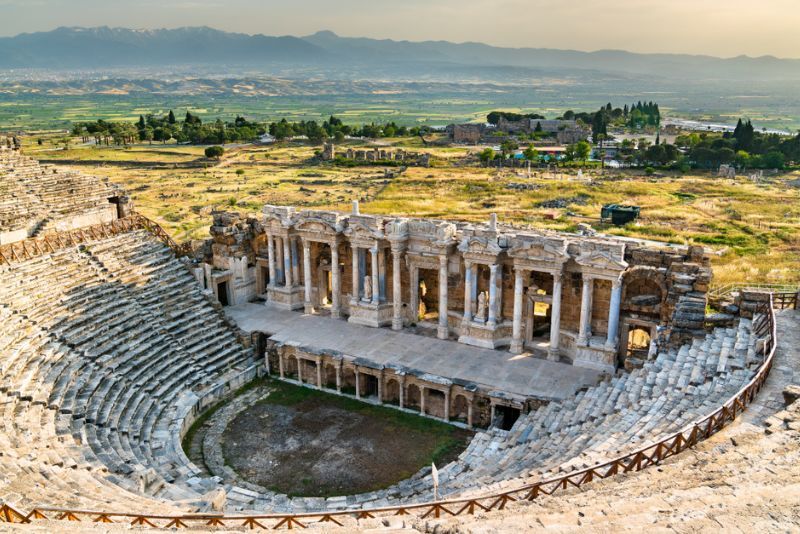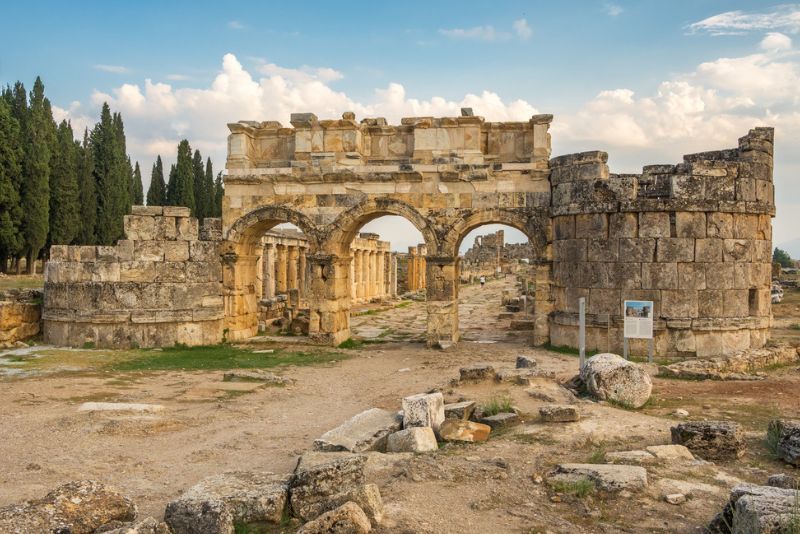Hierapolis: Day Trips and Tours from Alanya
Known for its warm weather, historic sites and sandy beaches, Alanya is a popular tourist destination in Turkey. But approximately 320 kilometers inland, the ancient city of Hierapolis offers visitors a journey back in time.
Resting high on the white limestone cliffs of Pamukkale, the ruins of Hierapolis bear witness to the grandeur of the Roman and Byzantine eras. On a Hierapolis day trip from Alanya, you'll traverse the picturesque Turkish countryside before the splendor of Hierapolis greets you.
Known for its warm weather, historic sites and sandy beaches, Alanya is a popular tourist destination in Turkey. But approximately 320 kilometers inland, the ancient city of Hierapolis offers visitors a journey back in time.
Resting high on the white limestone cliffs of Pamukkale, the ruins of Hierapolis bear witness to the grandeur of the Roman and Byzantine eras. On a Hierapolis day trip from Alanya, you'll traverse the picturesque Turkish countryside before the splendor of Hierapolis greets you.

(0/24) checking Musement...
Known for its warm weather, historic sites and sandy beaches, Alanya is a popular tourist destination in Turkey. But approximately 320 kilometers inland, the ancient city of Hierapolis offers visitors a journey back in time.
Resting high on the white limestone cliffs of Pamukkale, the ruins of Hierapolis bear witness to the grandeur of the Roman and Byzantine eras. On a Hierapolis day trip from Alanya, you'll traverse the picturesque Turkish countryside before the splendor of Hierapolis greets you.
This UNESCO World Heritage site, once a bustling Roman spa town, is an archaeological wonder filled with remnants of temples, bathhouses, and a beautifully preserved theater, all resonating with tales from antiquity.

Here's all you need to know about Hierapolis, one of the most exciting day trips from Alanya.
How to get to Hierapolis from Alanya?
Hierapolis is located above the sparkling travertine pools of Pamukkale, in Turkey’s Denizli Province. It lies roughly 320 kilometers north-west of Alanya and Istanbul is 600 kilometers to the north.
From Alanya to Hierapolis by car
You can drive from Alanya to Hierapolis in under 5 hours if there are no unexpected delays. The fastest route is via Mersin along the Antalya Yolu and D400.
From Alanya to Hierapolis by bus
Bus services travel daily between Alanya and Denizli. From Denizli you can get a taxi to Hierapolis and Pamukkale. A bus trip can take 6 hours or longer, and schedules may change. If you are on a tight budget, but considering overnighting in the area, then this may be an option for you.
Guided tour to Hierapolis from Alanya
One of the most convenient ways of visiting Hierapolis from Alanya is on a guided tour. Not only do you have the peace of mind knowing that all the arrangements have been taken care of, but you can sit back, relax and enjoy the scenic journey inland.
Guided tours typically start with a very early morning collection. Tours usually take place on a small group basis in a comfortable coach or minivan, but coach tours also operate from some locations. A trip from Alanya to Hierapolis is a full-day excursion, lasting anywhere between 18 and 20 hours with a late evening return.
How much does the entrance ticket to Hierapolis cost?
There are four different entrances to Hierapolis: the North and South entrances, the Walkway (Pamukkale), and the Antique Bath entrance. To enter Hierapolis, including the archaeological site, museum and Pamukkale costs TL400 (approximately US$18).
If you self-drive, parking will cost an additional TL20 (approximately US$1)
Up to 10 tickets can be purchased online, and purchase terms and conditions apply. Tickets bought on site are only valid on the day of purchase and only Turkish Lira is accepted as payment. You can purchase a museum pass if you are planning visits to multiple sites to save on entrance fees.
What is the typical itinerary?

A typical day tour to Hierapolis gets off to an early start with a collection from your Alanya hotel. Your guide will accompany you on your journey to the UNESCO World Heritage Site that comprises Pamukkale and Hierapolis.
They will provide you with details of the rich history of the region. Excursions usually begin with a visit to the fascinating travertine pools at Pamukkale before an exploration of the ancient city of Hierapolis, the Hierapolis archaeology museum, and the Cleopatra antique pool.
Tours include lunch and either breakfast or dinner, depending on the start time of your tour
What kinds of tours are available to go to Hierapolis?
A journey to Hierapolis from Alanya covers a significant distance and you can expect a long day of traveling and sightseeing.
Full-day guided tour to Hierapolis plus Pamukkale from Alanya
You can expect a rich and immersive experience when you embark on a full-day guided tour from Alanya to Hierapolis. The day typically begins with an early morning pickup from your hotel in Alanya. Enjoy a comfortable scenic journey as you traverse towards Pamukkale, where the ancient city of Hierapolis is perched atop white mineral-rich cliffs.
An expert guide will lead you through well-preserved ruins, sharing captivating stories and historical insights about this ancient Greco-Roman and Byzantine city. Before or after exploring Hierapolis, there's usually time to visit the neighboring natural wonder of Pamukkale, with its breathtaking white travertine terraces formed by mineral-rich thermal springs.
As the day concludes, you can relax and reflect as you travel back to Alanya.
How much does a day trip to Hierapolis from Alanya cost?
Full-day guided tours to Hierapolis and Pamukkale from Alanya cost between €40 and €135 per person. Price is dependent on group size and the type of inclusions in the itinerary. The cost will typically include the services of a professional guide and transportation, as well as a meal. Not all tours include entrance fees, so it's best to check this beforehand.
What will you see and do?

Among the prominent attractions at Hierapolis are the Grand Roman Theater, the massive Necropolis, the ancient thermal baths, and the Temple of Apollo.
Grand Roman Theater
The Grand Roman Theater is one of the best-preserved parts of the Hierapolis. This large theatre could hold up to 15,000 spectators and its intricate design reveals a stage decorated with ornate friezes and statues depicting mythological scenes and figures. The acoustics of the theatre still impress today, reflecting the advanced architectural skills of the Romans.
Necropolis
The Necropolis is considered one of the best-preserved ancient cemeteries. It stretches for two kilometers and contains more than 1,200 graves. The graves range from simple tombs to ornate sarcophagi and grand mausoleums, showcasing the various burial traditions of the Greco-Roman and Byzantine periods. The site provides a fascinating glimpse into ancient beliefs about death and the afterlife.
Thermal baths
The ancient thermal baths were central to Hierapolis where they formed part of a famed health center during the Roman period. The remains of these baths indicate they were grand structures, often integrated into spa complexes with gymnasiums and libraries. One such bath has been converted into a museum, housing many artifacts found in Hierapolis.
Temple of Apollo
While not much of the Temple of Apollo remains standing, it's known to have been one of the city's most significant religious structures. The temple was believed to sit on a powerful seismic fault, a "Plutonium" or religious grotto, which emitted toxic gasses, and was dedicated to Apollo as the god of fine arts, sun, light, knowledge, and healing, but also as the god who had the power to send calamities to earth.
What are the opening times?
With the exception of the South Gate, entrances to Hierapolis open to visitors at 8 AM, closing at 9 PM in the summer, 8 PM in the spring and autumn months and at 6 PM in the winter.
The South Gate opens at 6:30 AM year-round, with seasonal closing times as per the other access points.
While most of Hierapolis is accessible daily, the archaeological site visiting hours may change depending on renovations and events.
When is the best time to visit Hierapolis?

The best time to tour Hierapolis is in the spring (April to June) or autumn (September and October). The climate during these periods is generally moderate, and the site is less crowded than in the high summer months.
Alternatively, if your goal is to sidestep the presence of other tourists completely, the winter months (November to March) may suit you. However, during this time, anticipate encountering cooler weather and the occasional rainfall.
Are there any tours to Hierapolis from other cities in Turkey?
Yes, there are tours departing from other cities in Turkey:
- Day trips to Hierapolis from Side
- Day trips to Hierapolis from Antalya
- Day trips to Hierapolis from Izmir
- Day trips to Hierapolis from Fethiye
- Day trips to Hierapolis from Kusadasi
- Day trips to Hierapolis from Marmaris
Travel tips
- Due to the site's ancient and rugged terrain, it's recommended to don comfortable footwear. However, to preserve the natural beauty of Pamukkale's travertine terraces, visitors are required to tread barefoot.
- During the height of summer, Hierapolis tends to attract a substantial number of visitors. To skip the heaviest foot traffic, consider arriving early in the morning or late in the afternoon.
- Temperatures can soar during the summer, so it's crucial to maintain hydration and bring along sun protection.
- Additionally, for an extra fee, visitors can enjoy a unique swimming experience in Cleopatra's Pool, also referred to as the Antique Pool. Here, you can soak in warm thermal waters while surrounded by submerged ancient columns.
- Lastly, don't miss a visit to the Hierapolis Museum. The museum showcases a wide array of artifacts unearthed in Hierapolis, providing visitors with a deeper insight into the city's history.
